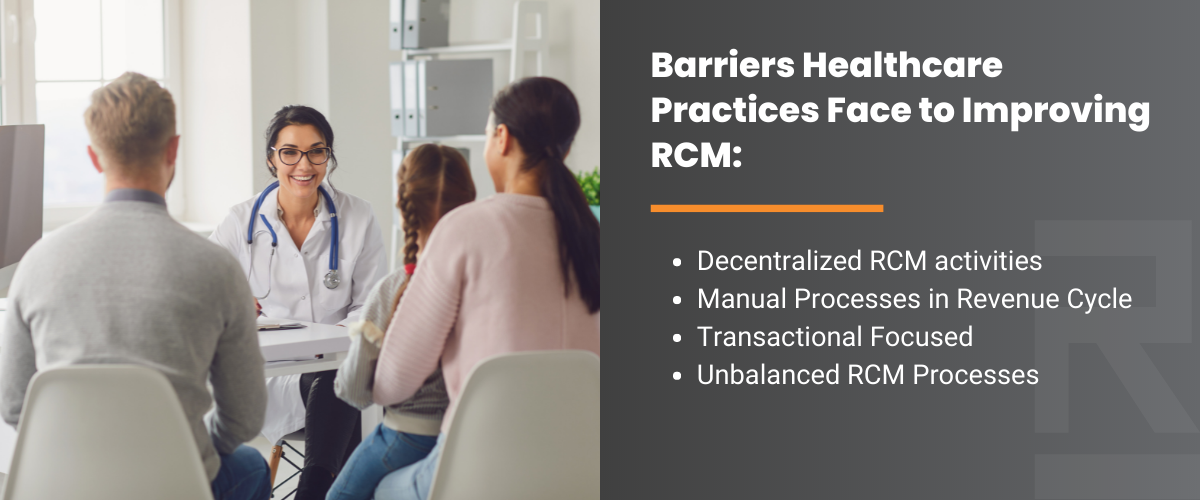Revenue cycle management (RCM) is a key factor in the financial success of any healthcare practice. Effective RCM makes it possible for healthcare practitioners to provide services that help protect the health and well-being of their patients and communities.
At its core, RCM encompasses all the actions you take to receive payment for the care you provide. The revenue cycle starts when a patient schedules an appointment and continues through registration, care delivery, claim submission, insurance adjustment, and balance billing.
Barriers Healthcare Practices Face to Improving RCM
Optimizing RCM is an ongoing pursuit for most healthcare leaders. But it’s no easy task. The revenue cycle is unwieldy. Staff and patients’ experience of the healthcare revenue cycle is often:
- Decentralized: RCM activities touch nearly every part of a healthcare organization but there is often a lack of communication and coordination between siloed departments.
- Manual: Inefficient, manual processes still dominate many areas of the revenue cycle.
- Transactional: Healthcare should be a relationship between the patient and provider, not just the purchase of a service.
- Unbalanced: Healthcare organizations have historically emphasized insurance reimbursement, neglecting the pre-care and post-care aspects of RCM.
Adding to these challenges, recent years have seen unprecedented disruptions to the healthcare industry, including:
- Falling revenues: A survey of primary care physicians in August 2021 by the Green Center and Primary Care Collaborative found that less than 30% of practices are financially healthy.
- Increasing out-of-pocket costs: Insurance companies are shifting more costs to patients through higher deductibles, copayments, and coinsurance. The Kaiser Family Foundation reports that deductibles for employer-sponsored health plans have increased 92% over the last decade. Collecting patient payments is more important than ever.
- Limited staff: You’re being asked to do more with less support. Over half of practices are unable to hire staff for open positions, according to the Green Center and Primary Collaborative survey.
- Shifting patient expectations: People want digital options for managing their healthcare expenses. A survey by PYMNTS and Rectangle Health found that 60% of healthcare consumers want text or email notifications about payments. More than half want access to payment plans and digital payment options.

RCM Reimagined
If your healthcare practice is struggling to modernize its current RCM practices, technology can help. Today’s automated solutions offer a more streamlined, holistic experience that promises to:
- Boost patient collections
- Improve patient satisfaction
- Reduce workflow inefficiencies
Digital strategies that can help revolutionize your revenue cycle include:
Online Registration Forms
For many offices, new patient registration is a labor-intensive process. Are you still relying on packets of paper? Wouldn’t it be easier to text or email new patients a link to the registration forms so they can complete them online at their convenience?
With such forms, information patients provide on their digital registration forms automatically populates the electronic health record. And the forms upload automatically, eliminating the tedious task of scanning forms by hand.
Not only does online registration save your office staff valuable time, it reduces check-in time — something all patients want. Digital registration also captures important payment information you need to collect future payments.
Convenient, Contactless Point-of-care Oayments
A best practice in healthcare billing is to collect payment while the patient is in your office. This reduces the need to chase payments later. Does your practice collect upfront payments? If so, do you offer patients the payment choices they want?
Payment trends are shifting, especially for younger patients. A CWH Advisors survey found that 57% of respondents between 18 and 34 prefer to pay using debit cards and digital wallets, such as Apple Pay. eMarketer reports that there were 43.9 million Apple Pay users in 2021 and estimates that over half of all smartphone users will use mobile wallets by 2025.
Most patients want to pay their healthcare bills. Digital wallets, touch-to-pay cards, mobile wallet apps, and QR code options make it faster and easier than ever to collect payments at the point of care.
Balance Billing
RCM managers know that collecting patient balances is a challenge and is only marginally effective. Healthcare practices collect only a fraction of payments owed.
This lost revenue weighs heavily on healthcare practice owners, especially those with fewer than five practitioners. According to a Black Book survey, 83% of small physician practices report that their top collection challenge is slow payments from high-deductible plan patients.
What’s more, the patient component of the Black Book survey found that:
- Approximately 60% of healthcare bills are paid online, but nearly 100% of patients would pay online if they could.
- More than 70% of patients say mobile pay and billing alerts have improved satisfaction with their provider.
- Nearly 60% of patients prefer an online payment method that eliminates the hassle of registration and passwords.
It’s clear from this data that balance billing needs to change. Indeed, balance billing is high-touch, manual work that’s ripe for automation. Consider a workflow that includes:
- Text or email billing statements, instead of paper statements
- Online and mobile payment options, instead of checks, cash, or payments over the phone
- Automatic patient payment posting, instead of manual data entry
The elimination of paper and manual tasks is better for staff and can lead to a shift in your company’s culture. It’s also better for patients who are primed and waiting for healthcare organizations to join the rest of the digital economy.
Let Rectangle Health Help You Accelerate Your Revenue Cycle
As a leader in digital patient payment solutions, Rectangle Health is here to help with revenue cycle management at your healthcare organization. With almost 30 years of experience, we’ve helped thousands of healthcare organizations streamline their processes and realize their goals of faster payments, higher revenues, and improved patient satisfaction.
Our leading platform, Practice Management Bridge®, reduces friction for you and your patients and interfaces seamlessly with your existing practice management system. We also adhere to today’s highest standards for healthcare and payment card industry compliance to provide secure healthcare payment information storage.
At Rectangle Health, we understand the value of offering contactless payments. That’s why we’ve designed Practice Management Bridge to support a range of payment options, including Text-to-Pay, mobile payments, online payments, Card on File, point of care payments, and patient financing. Additional features, such as digital registration forms and custom text messages, elevate your patient communications and help you meet today’s changing consumer expectations.
References
- Green Center, Primary Care Collaborative, 3rd Conversation. (2021). Quick COVID-19 Primary Care Survey: Series 30 Fielded August 13-17, 2021. Green Center, Primary Care Collaborative, 3rd Conversation. Retrieved June 1, 2022, from https://deepblue.lib.umich.edu/bitstream/handle/2027.42/170402/C19%20Series%2030%20National%20Executive%20Summary.pdf?sequence=1&isAllowed=y.
- Kaiser Family Foundation. (2021, November 10). Average Family Premiums Rose 4% This Year to Top $22,000; Employers Boost Mental Health and Telemedicine amid COVID-19 Pandemic, Benchmark KFF Survey Finds. Retrieved June 1, 2022, from https://www.kff.org/health-costs/press-release/average-family-premiums-rose-4-this-year-to-top-22000/.
- PYMNTS, Rectangle Health. (2021, January). The Healthcare Payment Experience Report. PYMNTS, Rectangle Health. Retrieved June 1, 2022, from https://www.pymnts.com/wp-content/uploads/2021/01/PYMNTS-The-Healthcare-Payment-Experience-Report-January-2021.pdf.
- eMarketer Editors. (2021, March 30). US payment users will surpass 100 million this year. Insider Intelligence. Retrieved June 1, 2022, from https://www.insiderintelligence.com/content/us-payment-users-will-surpass-100-million-this-year.
- (2017, October 24). Providers Driven to Implement Patient-Centric Financial Solutions as Consumer Payment Responsibility Skyrockets 29 Percent, Black Book Survey. Newswire. Retrieved June 1, 2022, from https://www.newswire.com/news/providers-driven-to-implement-patient-centric-financial-solutions-as-20015628.
